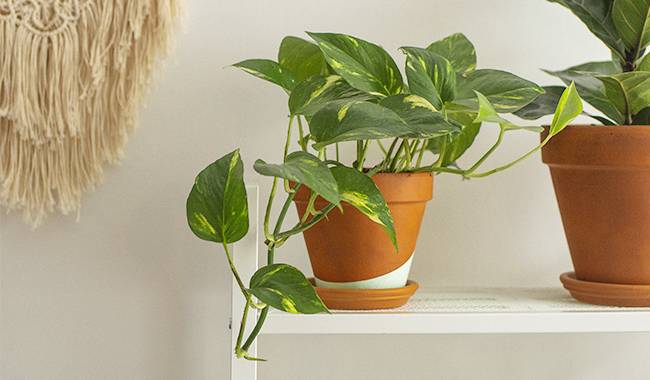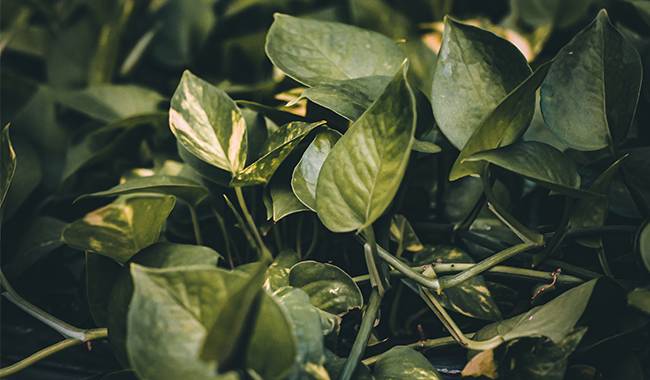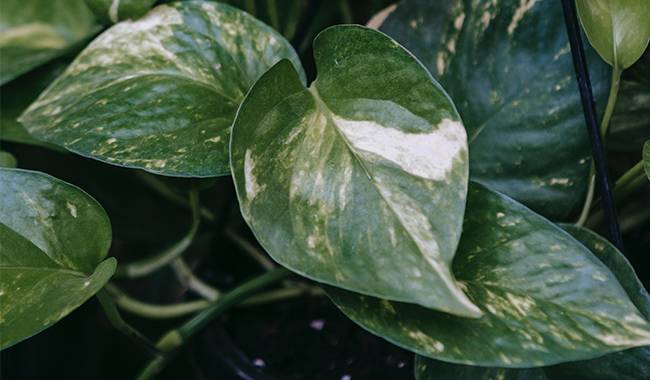
Epipremnum is an exceptional vine for true lovers of classical beauty. Its smooth, solid foliage may look dull, but only at first glance. An ideal candidate for growing on green columns and supports, Epipremnum is a plant made for shaping. Its remarkable plasticity, desirable appearance, and stable decorative qualities can compensate for some care problems even in the shade. And the conditions required for epiphytic plants are moderate. You will learn how to grow Epipremnum plants in the ThumbGarden article.
EPIPREMNUM PLANT DESCRIPTION
Among plants with phytocidal properties and the ability to improve air quality, Epipremnum is one of the unconditional favorites. But it is also unique for its ornamental talents. Thanks to its hardy, flexible shoots, Epipremnum is ideal for screens, screens, and shapes.
The botanical name Epipremnum perfectly describes the growth characteristics of the semi-epiphyte (from the Greek word meaning “on the trunk”), but the plant is still often referred to as Scindapsus in our area.
Epipremnum is an evergreen climbing vine in the Acanthaceae family with very slender and flexible branches up to 80-120 inches (2-3 m) long. Two types of progressively lignified aerial roots, trophy roots and attachment roots, grow from the stems. Elongated ridges and remnants of deciduous leaves can be seen in the internodes of young branches, and older branches gradually become lignified.
The leaves of Epipremnums are strikingly and evenly distributed throughout the shoot and increase in size with age. In nature, old leaves change shape to pinnate profiles or perforations, decorating with incisions along the central vein. However, this rarely happens in indoor conditions.
The skin is mild, less dense, and sits on a long petiole with heart-shaped or oval leaves that appear perfectly symmetrical due to the sharp tips. The smooth surface sheen is a constant feature of Epipremnum, as is the presence of spots and patterns on the leaves. The basic green tones are always bright, and the mottled, irregularly scattered white or yellow patterns add to their splendor.
Indoor Epipremnum hardly ever bloom. Inflorescence-sticks covered with dirty salad colors can only be formed on older shrubs with formed “mature” leaves.
Epipremnum is among the poisonous plants that need attention because contact with its sap irritates mucous membranes and the skin.
TYPES OF INDOOR EPIPREMNUMS PLANTS

Only a few species of Epipremnum are compact enough to grow indoors.
Epipremnum aureum is the most common species, with a slender “kit” of clinging shoots up to 80 inches (2 meters) long and ideal heart-shaped leaves decorated with irregular golden spots and stripes. The number, size, and intensity of the spots depending on the brightness of the light.
The plant is available in several attractive speckled varieties.
Marble Queen: creamy white salad ‘Marble Queen’.
NJOY: Fine leaves with contrasting white and emerald spots. ‘Enjoy.’
Devil’s ivy: Large leaves, more elongated and pointed, almost entirely yellow leaves ‘Golden Pothos’.
Epipremnum silvaticum: Two green-leaved species that have been neglected undeservedly. These are Epipremnum silvaticum, with very beautiful, glossy leaves up to 8 inches (20 cm) long, completely elliptic-lanceolate in shape, grooved at the base, and dark woody green in color.
Epipremnum pinnatum has small, wrinkled, densely veined oval leaves, age covered with pores or symmetrically divided into lobes. The light, lusterless underside of the leaves accentuates the beauty of the glossy, mirror-like dark emerald leaves above.
GROWING CONDITIONS FOR INDOOR EPIPREMNUM PLANTS
It is no coincidence that this amazing plant is included in the list of the hardiest and shade-loving cultivars. Epipremnum is a truly immortal grass that can be grown almost anywhere indoors.
Lighting and Placement
Epipremnum has a unique talent for adapting to almost any kind of lighting. The only thing it cannot tolerate is direct sunlight on any epidermal cells. The degree of shading possible is determined by the desire to maintain the pattern.
With gradual adaptation, epiphytes grow very well and look luxurious in light scattered situations, as well as in semi-shade and even in the shade. However, the worse the light, the greater the loss of pattern. In order to display mottled patterns covering almost all leaves, as bright a light as possible is needed, and for green-leaved species and varieties (or if color can be sacrificed), even shady light is acceptable.
Temperature control and ventilation
This plant is ideal for those who do not have a cool place in their home. Epipremnum grows well at room temperature and does not require any special overwintering habitat. It doesn’t like heat very much, but it is easily compensated with care.
Epipremnum does not like drafts. Drying should be done regularly but mitigated by protective measures. Because they do not like temperature changes and are tolerant of 59 °F (15°C), Epipremnums are not usually brought into the fresh air.

HOW TO TAKE CARE OF EPIPREMNUM PLANTS AT HOME
Magical plants of tropical origin should not be misled. They can grow without high air humidity but are very demanding in terms of watering.
Watering and air humidity
Epipremnum prefers generous watering, but no standing water in the water dish and wiping the top layer of substrate dry between waterings. In winter, water is slightly less depending on how quickly the soil dries out. Epipremnum is more afraid of overwatering than drought, and they will indicate too much water by droplets on the back of the leaves. Only soft water is suitable.
Epipremnums tolerate dry air well despite their tropical appearance and will only accept extra sprinkles in high temperatures. Foliage should be wiped regularly with a damp sponge, and dust should be avoided.
Nutrient and Fertilizer Composition
Epipremnum can be fertilized during its most vigorous growth period and during its dormant period. The standard frequency of fertilization is every 2 weeks from April to September, and once a month from October to March is sufficient. A special fertilizer for embroidered or ornamental foliage is best for this plant.
Pruning and trimming epiphytes
Young shrubs can be used to create waterfalls, green falls, and plants in ampelagic areas. Most commonly, however, epiphytes are planted on posts, trellises, and columns to create green walls, screens, and screens. Although vines have a talent for clinging to support, regular guidance of the branches is a must.
By pruning to thicken or cut off overgrown shoots, Epipremnum can be shaped as needed. To rejuvenate, cut old branches to the stump, leaving 1-2 leaves. Prune and clean, remove damaged, dry branches several times a year.
Repotting, containers, and substrates
This Epipremnum plant can be grown in a slightly acidic substrate or hydroponics. Loose or prickly soil or substrates for deciduous plants are ideal. Epipremnum does not like too large containers and should be grown in compact containers with a reticulated root system. The width of the pot should exceed its depth. When transplanting, the container should be increased by no more than 1 inch (2.5 cm).
Repotting is done after the ground of the previous container is fully developed, using the transplanting method. The most ideal time is mid-spring. When transplanting, a high drainage layer is placed at the bottom.
Diseases, pests and cultivation problems
This vine is subject to rot, spider mites, scabies, thrips, and aphids in unsuitable temperatures and constant neglect. Epipremnum plants are quickly attacked by rust and fungal diseases. If you notice any signs of infestation, isolate the plants immediately and treat them with a systemic insecticide or fungicide.
If the soil becomes dry, especially frequently, the tips and leaves will dry out, and black spots will appear on the leaves. Changes in color and the disappearance of patterns always indicate improper lighting choices.
Propagation of Epipremnum
Epiphyllum can be easily propagated and regenerated by fast and effective rooting cuttings. Either root tip cuttings or stem cuttings with 2 or 3 leaves can be rooted in water or a substrate under mulch.
The bracts of Epipremnum are also easy to root: the twigs are nailed in separate pots and separated as separate bracts after rooting. Mature shrubs can be divided.







